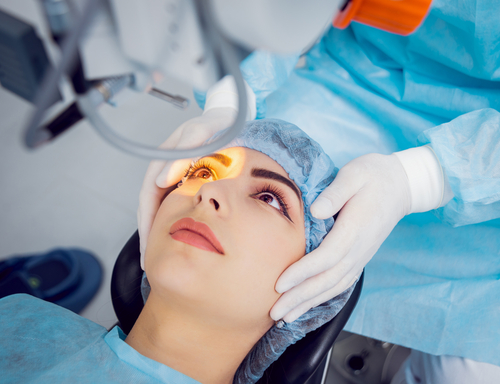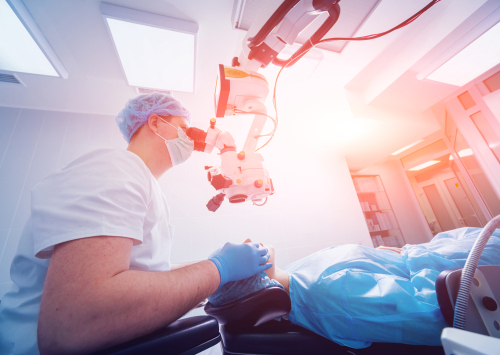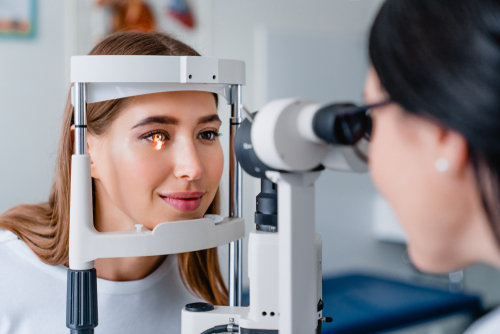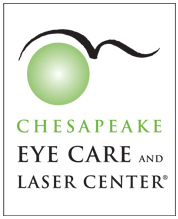What Happens During LASIK and SMILE?
July 28, 2023
Are you tired of having to rely on prescription glasses or contact lenses to see your world clearly? It may be time for you to consider a laser vision correction procedure!
At Chesapeake Eye Care and Laser Center, we offer two of the most popular and technologically advanced options: LASIK and SMILE. While both have high rates of success and patient satisfaction, it is important to learn more about each in order to choose the one that is right for your eyes!
What is LASIK?
LASIK stands for Laser-Assisted In Situ Keratomileusis. It is a vision-correcting laser refractive surgery that can effectively treat individuals with nearsightedness, farsightedness, and astigmatism.

LASIK is the most popular and widely-known vision-correcting procedure performed by eye surgeons today. The outcome for ninety percent of all LASIK patients is permanent, fully restored vision with reduced dependence on visual aids.
The LASIK procedure is relatively quick, with short recovery times, and is performed right in our office. The typical recovery time for LASIK patients is six to twelve hours, with fully restored vision within a few days of the surgery.
What Happens During LASIK?
When you choose to correct your vision with a LASIK procedure, the first step is a full examination of your eyes to determine whether you are a good candidate. The ideal candidate for LASIK is over the age of eighteen, has a stable prescription, has corneas of an acceptable thickness, and is in good health overall, with no serious chronic health conditions.

During the procedure, your LASIK surgeon will begin by numbing your eyes with special eye drops. Once your eyes are numb, your surgeon uses a special laser to make a flap on the surface of your cornea, which is the transparent outer layer at the front of your eye.
Your LASIK surgeon will then use the laser to reshape the cornea, correcting your refractive error which is affecting your clear vision. Once the procedure is complete, your eye doctor will replace the flap to facilitate healing post-surgery.
Typically, the LASIK procedure takes less than five to ten minutes per eye, depending on the exact correction to be made.
What Happens After LASIK?
Following your procedure, you should take some time to rest and recover. Your eyes may initially be sensitive to light, so it is advisable to avoid sunlight and take a break from viewing electronic screens.
While your eyes may experience some post-procedure discomfort, like itchiness, tearing, and redness, these symptoms clear up within a day or two. Although your vision will likely be restored much sooner, your eyes will be fully healed in about three months.
What is SMILE?
SMILE stands for Small Incision Lenticule Extraction. Like LASIK, it is a vision-correcting laser refractive surgery, but where LASIK can correct a number of refractive problems, SMILE is best used to correct myopia which is nearsightedness, or astigmatism.
SMILE is one of the latest and most advanced laser refractive surgery technologies available today. Approved by the FDA in 2016, it has been successfully used in more than sixty countries for over a decade, and it is estimated that over five million SMILE surgeries have been performed worldwide.
Like LASIK, the SMILE procedure is performed right in our office, and SMILE patients report similar recovery times to LASIK patients. Amongst patients who have undergone a SMILE procedure, ninety-nine percent report vision of 20/40 or better within six months, and eighty-four percent say that they have fully restored 20/20 vision.
What Happens During SMILE?
A SMILE procedure also begins with a comprehensive examination of your eyes to determine whether SMILE is the right procedure for you. To be a good candidate for SMILE, you should be over twenty-two, have a prescription that has not changed in at least twelve months, and have an eye prescription within an acceptable range for both nearsightedness, astigmatism, or a combination of the two.
After numbing your eyes, your eye surgeon uses a technologically-advanced femtosecond laser to create a tiny incision across the surface of your eye. Using the femtosecond laser, they create a thin disc of tissue, called a lenticule, within the layers of your cornea.
Your SMILE surgeon then removes the lenticule. By removing the lenticule, the shape of your cornea is changed, correcting your eye’s refractive error and restoring your vision.
 What Happens After SMILE?
What Happens After SMILE?
While you should take the same post-surgery precautions as with a LASIK procedure, generally, the incision made during a SMILE procedure heals more quickly than the flap created by LASIK. SMILE patients can usually get back to their normal activities within a day or so.
Some SMILE patients report that their vision is restored almost immediately, while most report completely clear vision in about a week. After SMILE, you can expect your eyes to be fully healed in three to six months.
LASIK versus SMILE: Which One is Right for Me?
There are a number of factors to consider when you are trying to determine which procedure is right for you. One significant factor is often the refractive error you need to correct and how strong your prescription is.
Those who are considering SMILE must have eye prescriptions which fall within a set range of acceptability. In contrast, LASIK is not as limited and can be used to correct the vision of a broader range of individuals.

A third factor is eye health. Because patients with dry eye syndrome can be at high risk for post-procedure complications following LASIK, SMILE could be the better choice as it usually does not cause dry eye during recovery.
Both LASIK and SMILE are safe and effective ways to correct refractive errors and restore your clear vision. While they both have their advantages, ultimately, the best way to determine which one will offer you the best treatment outcome is to consult with your eye surgeon.
An experienced eye surgeon, like the team at Chesapeake Eye Care and Laser Center, can advise you on the procedure that will best suit your individual vision needs!
Are you interested to see clearly without having to rely on corrective eyewear? Schedule an appointment at Chesapeake Eye Care and Laser Center in Annapolis, MD, today!



